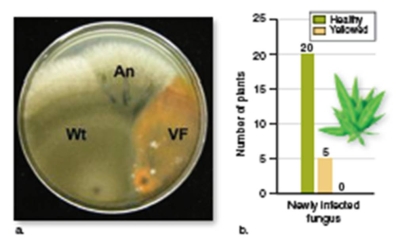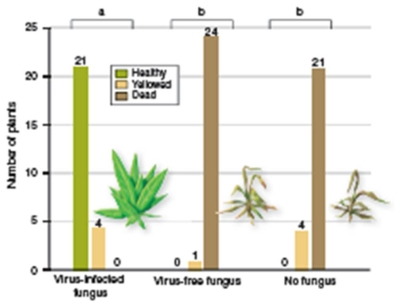A) Phosphorous cycle
B) Nitrogen cycle
C) Water cycle
D) Energy cycle
E) Carbon cycle
G) A) and C)
Correct Answer

verified
Correct Answer
verified
Multiple Choice
A ________________________ makes up a small portion of the community by weight,yet exerts a disproportionate influence on community diversity.
A) Keystone species
B) Cornerstone species
C) Capstone species
D) Flagstone species
E) None of the above are correct
G) All of the above
Correct Answer

verified
Correct Answer
verified
Multiple Choice
An insect that resembles leaves is using ___ to avoid predation.
A) Camouflage
B) Warning coloration
C) Mimicry
D) Chemical defense
E) Mutualism
G) A) and E)
Correct Answer

verified
Correct Answer
verified
Multiple Choice
figure 37.20  -What did the scientists conclude from figure 37.20?
-What did the scientists conclude from figure 37.20?
A) Adding the virus back to virus-free fungi decreased plant survival
B) Infecting plants with the virus increased their survival
C) Infecting plants with the virus decreased their survival
D) Infecting the fungus with the virus allowed them to grow in the heat
E) Adding the virus back to virus-free fungi increased plant survival
G) C) and D)
Correct Answer

verified
Correct Answer
verified
Multiple Choice
figure 37.19  -What is the dependent variable in figure 37.19?
-What is the dependent variable in figure 37.19?
A) Number of plants that could grow at 37°C
B) Number of plants that could grow at 65°C
C) Number of plants that died at 65°C
D) Number of plants that died at 37°C
F) None of the above
Correct Answer

verified
Correct Answer
verified
Multiple Choice
A type of symbiosis in which one member of the relationship benefits and the other is harmed is:
A) Predation
B) Mutualism
C) Commensalism
D) Parasitism
E) Intraspecific competition
G) A) and B)
Correct Answer

verified
Correct Answer
verified
Multiple Choice
When two or more species vie for the same limited resource _____________________ occurs.
A) Succession
B) Symbiosis
C) Coevolution
D) Stotting
E) Competition
G) None of the above
Correct Answer

verified
Correct Answer
verified
True/False
Lichens and mosses that can grow on and erode rock would be considered pioneer species.
B) False
Correct Answer

verified
Correct Answer
verified
Multiple Choice
Abiotic components of an ecosystem include:
A) Living components only
B) Both nonliving and living components
C) Only plant life
D) Nonliving components only
E) Only animal life
G) C) and E)
Correct Answer

verified
Correct Answer
verified
True/False
A network of interconnected food chains is a food web.
B) False
Correct Answer

verified
Correct Answer
verified
Multiple Choice
The adaptations in Pseudomyrmex species and acacias suggest that the two species ______________.
A) Have coevolved
B) Have intermingled
C) Have evolved separately
D) Occupy the same niche
E) Occupy the same tidal zone
G) A) and E)
Correct Answer

verified
Correct Answer
verified
Multiple Choice
The concentration of the pesticide DDT would be lowest in which of the following?
A) A seagull
B) A minnow
C) A mosquito larvae
D) Algae
E) Plankton
G) B) and D)
Correct Answer

verified
Correct Answer
verified
Multiple Choice
The concentration of the pesticide DDT would be highest in which of the following?
A) A minnow
B) A mosquito larvae
C) A seagull
D) Plankton
E) Algae
G) A) and D)
Correct Answer

verified
Correct Answer
verified
Multiple Choice
Mistletoe is a plant that grows in the branches of other trees.Its roots penetrate the bark of the tree obtaining water and nutrients from the tree.This is an example of:
A) Mutualism
B) Commensalism
C) Predation
D) Parasitism
E) Herbivory
G) None of the above
Correct Answer

verified
Correct Answer
verified
Multiple Choice
Why are keystone predators like lions and eagle so rare in a community?
A) Because only a small amount of the energy is passed from one trophic level to the next
B) Because they do not breed as fast as other animals
C) Because of predation by higher predators
D) Because it is difficult for them to learn how to capture prey
E) Because their job is to keep the population size of other animals in check
G) D) and E)
Correct Answer

verified
Correct Answer
verified
True/False
The term abiotic means "nonliving".
B) False
Correct Answer

verified
Correct Answer
verified
Multiple Choice
The energy requiring process by which liquid water becomes water vapor (a gas) is:
A) Sublimation
B) Condensation
C) Convection
D) Evaporation
E) All are correct
G) A) and B)
Correct Answer

verified
Correct Answer
verified
Multiple Choice
Which of the following is not an important biogeochemical cycle on Earth?
A) ATP cycle
B) Water cycle
C) Carbon cycle
D) Phosphorous cycle
E) Nitrogen cycle
G) B) and C)
Correct Answer

verified
Correct Answer
verified
True/False
Parasitism is a symbiotic relationship in which neither member of the relationship benefits.
B) False
Correct Answer

verified
Correct Answer
verified
Multiple Choice
Which of the following is not a type of symbiosis?
A) Parasitism
B) Mutualism
C) Commensalism
D) Predation
E) None of the above are correct
G) A) and D)
Correct Answer

verified
Correct Answer
verified
Showing 61 - 80 of 86
Related Exams